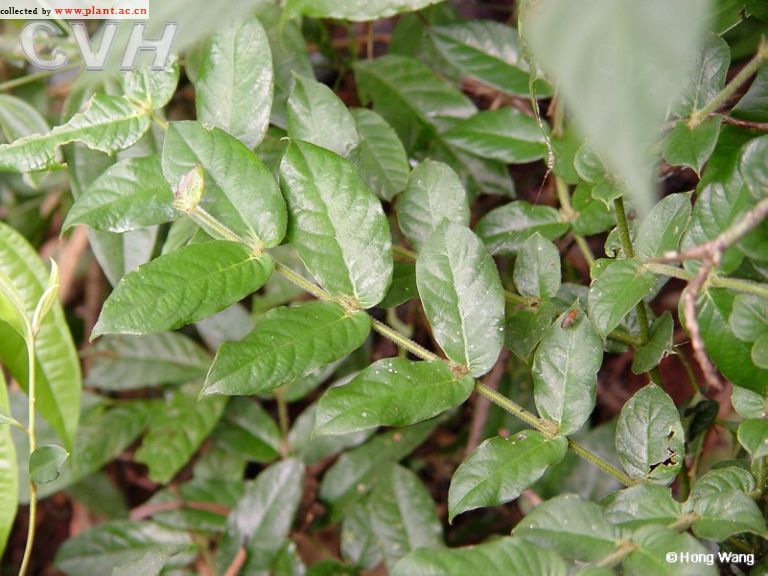斜基粗叶木Lasianthus wallichii (Wight et Arn.) Wight
斜基粗叶木Lasianthus wallichii (Wight et Arn.) Wight
1.斜基粗叶木(海南植物志)图版18:1-7
Lasianthus wallichii (Wight et Arn.) Wight in Calc. Journ. Nat. Hist. 6: 503. 1846; Kurz, For. Fl. Brit. Burma 2: 31. 1877; Hook. f. Fl. Brit. Ind. 3: 180. 1880; Hemsl. in Journ. Linn. Soc. Bot. 23: 389. 1888; Henry, List Pl. Formos. 51. 1896; Matsum. et Hayata, Emum. Pl. Formos. 197. 1906; Dunn et Tutch. in Kew Bull. Misc. Inf. add. ser 10: 134. 1912; Matsum. Ind. Pl. Jap. 2 (2): 590. 1912; Hayata, Ic. Pl. Formos. 2: 99. 1902; Merr. in Lingnan Sci. Journ. 5: 177. 1927; Chun in Sunyatsenia 1: 162. 1933; 陈嵘, 中国树木分类学1139. 1937; Kanjilal, Fl. Assam. 3: 90. 1939; Kar et Panigrahi in Bull. Bot. Surv. 5 (3/4): 231. 1963; 海南植物志3: 335. 1974; 中国高等植物图鉴4: 250, 图5914. 1975; Hara et Gould in Hara et al. Enum. Flow. Pl. Nepal 2: 204. 1979; 西藏植物志4: 449, 图192 (1-4). 1985; H. Zhu in Acta Phytotax. Sinica 32 (1): 56. 1994. ——Mephitidia wallichii Wight et Arn. Prodr. 1: 390. 1834, in nota——L. plagiophyllus Hance in Journ. Bot. 13: 196. 1875; Kanehira, Formos. Trees ed. 2: 570; Liu, Ill. Nat. Intr. Lign. Pl. Taiwan 2: 1120, f. 939. 1962; Liu et Chao in Taiwania 10: 147, fig. 16. 1964; 台湾植物志4: 303, 图1015. 1978. ——L. wallichii (Wight et Arn.) Wight ssp. plagiophyllus (Hance) C. Y. Wu et H. Zhu in Acta Phytotax, Sinica 32 (1): 57. 1994.
种中文名:斜基粗叶木
种拉丁名:Lasianthus wallichii (Wight et Arn.) Wight
科中文名:茜草科
科拉丁名:Rubiaceae
属中文名:粗叶木属
属拉丁名:Lasianthus
国内分布:闽,台,粤,桂,滇,港
命名来源:(海南植物志)[]
【药 名】:斜基粗叶木
【拼 音】:XIEJICUYEMU
【来 源】:为双子叶植物药茜草科植物斜基粗叶木的根。
【功 效】:舒筋活血。
【主 治】:风湿痹症、筋脉拘挛、跌打损伤等症。
【性味归经】:辛、甘,温。肝经。
【用法用量】:内服:6一12克,亦可外用。
【别 名】:圆叶鸡屎树(台湾、树木学)、小叶鸡屎树(广西、广东)
【动植物资源分布】:分布于福建、台湾、广东、广西、云南。
【拉丁名】:植物斜基粗叶木Lasianthus wallichii wight
【考 证】:始载于《海南植物志》。
《Flora of China》 Vol. 19 (2011)
Lasianthus attenuatus Jack Trans. Linn. Soc. London. 14: 126. 1823.
斜基粗叶木 xie ji cu ye mu
Lasianthus densifolius Miquel; L. setosus Craib; L. wallichii Wight; L. wallichii var. hispidocostatus H. Zhu.
Shrubs, 1-2 m tall; branches and branchlets densely tomentose to hirsute or sometimes setose. Petiole 1-3 mm, tomentose to hirsute; leaf blade leathery or subleathery, oblong, elliptic-lanceolate, or oblong-ovate, 5-12 × 2.5-5 cm, glabrous adaxially, strigillose to hirtellous or tomentose abaxially, base slightly cordate or rarely rounded, slightly to markedly oblique, apex acute to cuspidate-acuminate; lateral veins 6-8 pairs; nervules subparallel, conspicuous abaxially; stipules triangular or ovate-lanceolate, 2-3 mm, tomentose to hirsute, apparently persistent. Inflorescence cymose or glomerulate, sessile, densely hirsute to hirtellous; bracts subulate to lanceolate, 6-15 mm, persistent. Flowers sessile. Calyx densely hirsute; hypanthium portion campanulate, ca. 1 mm; limb 1-2 mm, with 5 triangular teeth. Corolla sparsely hirtellous, puberulent to glabrescent outside, villous inside; tube 8-10 mm; lobes 5, spatulate, 4-5 mm. Fruit globose or ovoid, 5-10 mm in diam., densely hirsute, smooth; pyrenes 5 or 6. Fl. Apr, fr. Aug-Sep.
Forests, shaded and wet places; 200-1800 m. Fujian, Guangdong, Guangxi, Hainan, Taiwan, Yunnan [Bhutan, Cambodia, NE India, Indonesia, S Japan, Laos, Malaysia, Myanmar, Nepal, Papua New Guinea, Philippines, Thailand, Vietnam].
别名:斜基鸡屎树;斜茎粗叶木;
科名:茜草科 Rubiaceae
属名:粗叶木属 Lasianthus

1.斜基粗叶木(海南植物志)图版18:1-7
Lasianthus wallichii (Wight et Arn.) Wight in Calc. Journ. Nat. Hist. 6: 503. 1846; Kurz, For. Fl. Brit. Burma 2: 31. 1877; Hook. f. Fl. Brit. Ind. 3: 180. 1880; Hemsl. in Journ. Linn. Soc. Bot. 23: 389. 1888; Henry, List Pl. Formos. 51. 1896; Matsum. et Hayata, Emum. Pl. Formos. 197. 1906; Dunn et Tutch. in Kew Bull. Misc. Inf. add. ser 10: 134. 1912; Matsum. Ind. Pl. Jap. 2 (2): 590. 1912; Hayata, Ic. Pl. Formos. 2: 99. 1902; Merr. in Lingnan Sci. Journ. 5: 177. 1927; Chun in Sunyatsenia 1: 162. 1933; 陈嵘, 中国树木分类学1139. 1937; Kanjilal, Fl. Assam. 3: 90. 1939; Kar et Panigrahi in Bull. Bot. Surv. 5 (3/4): 231. 1963; 海南植物志3: 335. 1974; 中国高等植物图鉴4: 250, 图5914. 1975; Hara et Gould in Hara et al. Enum. Flow. Pl. Nepal 2: 204. 1979; 西藏植物志4: 449, 图192 (1-4). 1985; H. Zhu in Acta Phytotax. Sinica 32 (1): 56. 1994. ——Mephitidia wallichii Wight et Arn. Prodr. 1: 390. 1834, in nota——L. plagiophyllus Hance in Journ. Bot. 13: 196. 1875; Kanehira, Formos. Trees ed. 2: 570; Liu, Ill. Nat. Intr. Lign. Pl. Taiwan 2: 1120, f. 939. 1962; Liu et Chao in Taiwania 10: 147, fig. 16. 1964; 台湾植物志4: 303, 图1015. 1978. ——L. wallichii (Wight et Arn.) Wight ssp. plagiophyllus (Hance) C. Y. Wu et H. Zhu in Acta Phytotax, Sinica 32 (1): 57. 1994.
种中文名:斜基粗叶木
种拉丁名:Lasianthus wallichii (Wight et Arn.) Wight
科中文名:茜草科
科拉丁名:Rubiaceae
属中文名:粗叶木属
属拉丁名:Lasianthus
国内分布:闽,台,粤,桂,滇,港
命名来源:(海南植物志)[]
【药 名】:斜基粗叶木
【拼 音】:XIEJICUYEMU
【来 源】:为双子叶植物药茜草科植物斜基粗叶木的根。
【功 效】:舒筋活血。
【主 治】:风湿痹症、筋脉拘挛、跌打损伤等症。
【性味归经】:辛、甘,温。肝经。
【用法用量】:内服:6一12克,亦可外用。
【别 名】:圆叶鸡屎树(台湾、树木学)、小叶鸡屎树(广西、广东)
【动植物资源分布】:分布于福建、台湾、广东、广西、云南。
【拉丁名】:植物斜基粗叶木Lasianthus wallichii wight
【考 证】:始载于《海南植物志》。
《Flora of China》 Vol. 19 (2011)
Lasianthus attenuatus Jack Trans. Linn. Soc. London. 14: 126. 1823.
斜基粗叶木 xie ji cu ye mu
Lasianthus densifolius Miquel; L. setosus Craib; L. wallichii Wight; L. wallichii var. hispidocostatus H. Zhu.
Shrubs, 1-2 m tall; branches and branchlets densely tomentose to hirsute or sometimes setose. Petiole 1-3 mm, tomentose to hirsute; leaf blade leathery or subleathery, oblong, elliptic-lanceolate, or oblong-ovate, 5-12 × 2.5-5 cm, glabrous adaxially, strigillose to hirtellous or tomentose abaxially, base slightly cordate or rarely rounded, slightly to markedly oblique, apex acute to cuspidate-acuminate; lateral veins 6-8 pairs; nervules subparallel, conspicuous abaxially; stipules triangular or ovate-lanceolate, 2-3 mm, tomentose to hirsute, apparently persistent. Inflorescence cymose or glomerulate, sessile, densely hirsute to hirtellous; bracts subulate to lanceolate, 6-15 mm, persistent. Flowers sessile. Calyx densely hirsute; hypanthium portion campanulate, ca. 1 mm; limb 1-2 mm, with 5 triangular teeth. Corolla sparsely hirtellous, puberulent to glabrescent outside, villous inside; tube 8-10 mm; lobes 5, spatulate, 4-5 mm. Fruit globose or ovoid, 5-10 mm in diam., densely hirsute, smooth; pyrenes 5 or 6. Fl. Apr, fr. Aug-Sep.
Forests, shaded and wet places; 200-1800 m. Fujian, Guangdong, Guangxi, Hainan, Taiwan, Yunnan [Bhutan, Cambodia, NE India, Indonesia, S Japan, Laos, Malaysia, Myanmar, Nepal, Papua New Guinea, Philippines, Thailand, Vietnam].

